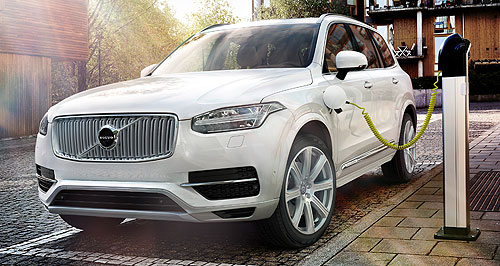News - VolvoVolvo to plug in model rangeCharging ahead: Volvo’s second-gen XC90 introduces the company’s new plug-in hybrid tech that will be rolled out across the model range in years to come. Pure EVs and hydrogen are out but Volvo ramps up plug-in hybrid roll out20 Feb 2015 By TIM NICHOLSON in BARCELONA ALL future Volvo models will be available with a plug-in hybrid drivetrain, but the car-maker has gone cold on full electric vehicles and hydrogen fuel-cell-powered cars, for now. Volvo held the media launch of its second-generation XC90 SUV in Spain this week, and the T8 plug-in hybrid version will kick off the company’s new suite of hybrid technology when it launches in Europe in the coming months. It is the second plug-in model from the Swedish car-maker, following the V60 diesel-electric PHEV wagon, but unlike that model, the XC90 plug-in is locked in to arrive Down Under later in the year. Speaking at the first media drive of the XC90 range in Spain this week, Volvo Cars Group product manager Lars Lagstrom confirmed that the new-generation PHEV technology would spread across the car-maker’s model range. “Yes, all cars in the future will be plug in,” he said. “Because we see it as the best way to go to reduce CO2. And also reach the performance level.” The Twin Engine hybrid powertrain in the XC90 T8 combines Volvo’s new Drive-E 236kW T6 petrol engine with a 60kW/240Nm electric motor and a 9.2kWh lithium-ion battery for a combined output of 294kW and 640Nm. It is Volvo’s most powerful model, beating the 257kW/500Nm output of the turbocharged V6-powered S60/V60 Polestar performance twins, and can race from 0-100km/h in 5.9 seconds. The XC90 T8 has an electric-only range of 40km and carries an official combined fuel consumption figure of 2.5 litres per 100 kilometres. Volvo’s shift to plug-in power means next-generation models including the XC60, V40, XC40, S60/V60 and the S80-replacing S90/V90 large car look set to gain PHEV powertrains. The move is in line with Volvo’s German rivals, with BMW, Mercedes-Benz and Audi all developing plug-in hybrid variants of a number of models. Audi has confirmed its XC90-rivaling Q7 will be offered in diesel-electric e-tron guise when it arrives in Australia later this year, and its 1.7L/100km figure undercuts the petrol-electric Volvo’s consumption. BMW is also working on a production version of the X5 eDrive concept it revealed at the 2013 Frankfurt motor show. In terms of pure electric vehicles, Mr Lagstrom said while Volvo’s new vehicle platforms, including the Scalable Product Architecture (SPA) underpinning the XC90 allow for full electrification, the company is not actively pursuing it. “Our platform can do most of it, but we don’t see the full electric vehicle is there yet. The infrastructure is not there. I mean Tesla is struggling to build up the superchargers and so on.” Mr Lagstrom said that data collected by Volvo showed that the 40km EV range of the XC90 covers 67 per cent of the daily commuting for drivers traveling from home to an office where the vehicle can be charged, and described the PHEV as having a “very big spare tank for going with a combustion engine in a most efficient way”. “We believe that is the future, also using the electricity to create the performance, you have both in one car,” he said. Volvo has dipped its toe into EV development in the past with the C30 DRIVe, but it never ventured beyond pilot programs and field testing into mass production. Despite a number of global manufacturers, including Toyota, Honda and Hyundai developing hydrogen fuel-cell technology, Mr Lagstrom said it is not on the cards for Volvo given the company’s size and research and development resources. “We are not that big a company,” he said. “We need to work with what is core, what can really be set into market. I think the ones (car-makers) that earn a lot more money than us and are much bigger, they have the funds to really look into that and I think the day they put it on the market, if it is needed for some areas, it will be possible to buy it before we know the technology ourselves. “You can’t be everywhere, we are a small company. We are 465,000 cars, in the world volume (last year) I think it was 65 million cars produced or something like that. We are small but we are working towards what we see the customer needs.”  Read more18th of February 2015  First drive: Volvo hits reset button with XC90Second-gen XC90 the first salvo in Volvo’s rebirth and new-model onslaught9th of July 2014  Volvo previews frugal XC90 plug-in techPlug-in hybrid Volvo XC90 SUV produces 299kW and class-leading emissions |
Click to shareVolvo articlesResearch Volvo Motor industry news |
















Facebook Twitter Instagram